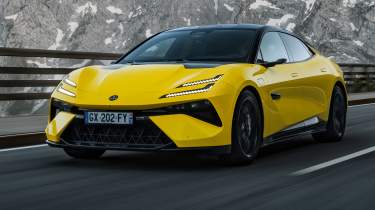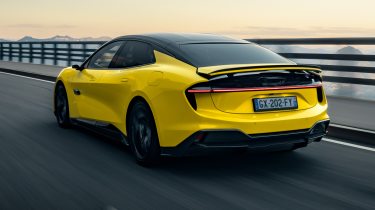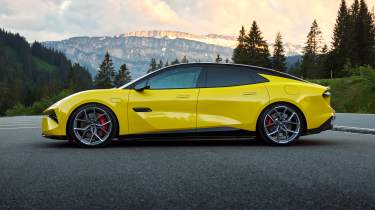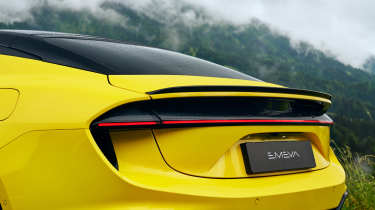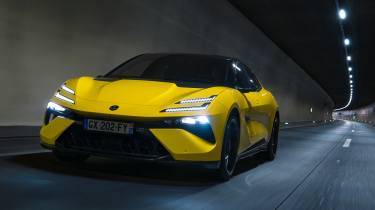Lotus Emeya 2024 review – the Porsche Taycan’s strongest challenger yet
It couldn’t be further from a traditional Lotus, but the Emeya addresses the challenges of an EV in a Lotus way
Porsche’s Taycan has owned the executive-super saloon-GT car segment since its launch back in 2019 with its Audi cousin, the e-Tron GT, picking up the crumbs. Outselling the 911 tells you all you need to know about the success of Porsche's big selling EV. Although a quick look at the residual values demonstrates the difference between a car purchase made with your heart and one by your accountant.
And now there’s a new rival in the form of the Lotus Emeya, available in three states of tune: Emeya, S and R with peak power and torque outputs differentiating with the entry model and S both generating 603bhp and 524lb ft with a single speed gearbox and the R sending 905bhp and 726lb ft through a two-speed ‘box.
> The Lotus Evija X is the second-fastest EV to lap the Nürburgring
It won’t surprise you to hear that the R is no slouch despite weighing 2590kg (no, that’s not a typo, it genuinely does weigh the equivalent of three and a half Elises), primarily because it has within its floor an 800-volt battery powering two permanently excited e-motors, one on each axle. With 726lb ft of torque, it is uncomfortably fast, applying forces upon its driver and occupants that, as with all high-end electric vehicles, cause your cerebral faculties to require some very rapid and immediate reprogramming, and your stomach to be suitably sturdy.
More reviews
Electric cars and their raw speed are nothing new, of course. Of more significance to people like us is how these rocket sleds drive. And just as their performance continues to grow at a stupendous rate, the pace at which electric cars’ chassis and dynamics are evolving is equally impressive. A new dawn? Maybe.
As with its Eletre SUV sister, the Emeya is built on Zeekr Technology’s Electric Premium Architecture, which uses a mixture of aluminium and steel to link the front and rear subframes with the lithium-ion battery positioned in the middle of the car. This structure is wrapped in aluminium body panels, the design retaining Lotus’s cab-forward ethos with nods to the Evija hypercar with its openings in the rear bumpers just behind the wheels.
At over five metres long (its wheelbase is over three metres and its width up to 2.2 metres depending on which mirrors you go for) it’s not exactly a delicate little thing, but it looks no more outsized than a previous-generation BMW 5-series. It doesn’t really look like a Lotus either, but then the company has never had a four-door, four-seat GT car in its production portfolio until now.
In your mirrors the Emeya does have a real presence about it, from its nose-down stance snorting up the road to the athletic sculpting of the frunk cover, which can be specified with the upper portion finished in exposed carbonfibre, though that’s probably best avoided as it jars with the overall look. The Emeya’s long body is exaggerated by that cab-forward design, and with a thinner battery than that fitted to the Eletre and a lower ride height it’s a far more cohesive design. The rear is a little bland, with the aero elements, including a two-stage active rear wing, being the most distinctive aspects. And there’s no easy way of telling what it is, the rear ‘LOTUS’ lettering being black-on-black on the R, rendering it all but invisible, while the model name isn’t shown at all – which all seems a bit too far down the trendy minimalist route when you’re launching into a whole new sector with a model you have no legacy with. If ever a car needed clear badges to tell other motorists what it is, it’s a 2.5-ton Lotus saloon car. Although if you saw it alongside Audi’s e‑tron GT and Porsche’s Taycan, chances are you’d be drawn to the Brit’s more distinctive style.
And if you had the chance to poke around inside? Leaving aside the fact that the seat is positioned too high, Lotus has created an interior that matches its claims for the Emeya being a hyper-GT. A high central tunnel provides a cocooning environment, wrapping you inside the car, and the large central screen is intuitive to use – and quick in its response times – as well as looking as integrated as these things ever can. Lotus has also avoided the temptation to position switchgear somewhere different just for the sake of it, which is very welcome. The digital-monitor wing mirrors take time to adjust to, your head instinctively looking at the skeletal arm hanging off the bodywork and staring at the camera within it rather than looking at the screen embedded within the door card. Conventional mirrors are also available; unfortunately a conventional instrument binnacle isn’t, the Emeya utilising a thin strip to display just how quickly you’re suddenly going after merely thinking about applying some throttle.
All that forward motion is applied by the 225kW (302bhp) motor on the front axle and the 450kW (604bhp) unit on the rear, with a two-speed gearbox there to optimise the R’s acceleration both off the line and to maintain it up to its 159mph maximum. And it’s uncomfortably effective. From a standing start the instant response to any application of the throttle has the Emeya leaping for the horizon, but it’s the roll-on acceleration when you’re travelling at 50mph and introduce the throttle pedal to its stop that shocks. Another 50mph is added to your speed in what feels like an instant. Another 30mph is added instantly after this and then shortly afterwards the warning light illuminates and the bong sounds. That’s your lot.
With this level of performance you need a secure platform beneath you, which the Emeya R has, though it doesn’t feel quite as secure as that of its lesser S brother. In addition to the air suspension and dual-valve active dampers fitted to both versions, the R also has active anti-roll control, which feels a step too far to me and can make the flagship seem slightly nervous. It’s down to the chassis constantly reacting to everything it senses about the surface that its Pirelli P Zero Rs are traversing, the result being that at times it feels like all four corners are pulling in slightly different directions, reacting and working on their own rather than collectively. Even on a mirror-smooth section of autobahn you can feel the chassis is busy making small adjustments.
Away from the high-speed stuff it’s calmer, but with every throttle application there’s a twist and a tug through the car as each corner works independently to find a perfect dynamic equilibrium that probably doesn’t exist. Floor the R out of what would be a second-gear corner in a combustion-engined car and not only does the acceleration make you feel slightly queasy but the movement through the car throws you off balance.
Which is why the less powerful S, with a tardy 603bhp and 524lb ft – I know, how will you manage? – with its air springs and active dampers but no active roll technology, is a much sweeter package, one that shows off the Emeya’s ability far better. It’s still fast enough in a straight line if that’s what’s important to you and your ego, but crucially it’s a far calmer and smoother car to drive. There’s none of the constant fidgeting through the chassis; instead you can tap into the performance available, build a rhythm and better experience what Lotus is known for: clean, linear steering and a ride that allows the car to breathe with the road but without any numbing isolation. There’s more roll on turn-in and you can feel and hear the 22-inch tyres – Michelin Pilot Sport 4 Ss – being worked, but it’s a more natural and connected drive.
You still have little adjustability via the throttle, but there’s a natural balance to how it behaves, the way it rolls into a corner, transfers and manages its weight and conveys an attitude and character missing in so many electric cars, including Porsche’s generally impressive Taycan.
Both Emeya models are equipped with sizeable carbon-ceramic brakes: 412mm discs with six-piston calipers on the front axle. There’s good pedal modulation that allows you to bleed off speed as required, and the regen is well integrated, although in Sport mode and above it fades into the background.
The S’s less hyperactive nature also makes it a more convincing long-distance car, its calmness across multiple surfaces exactly what you’d expect from something portrayed as a GT. So would you take an Emeya S on one of those continental road trips that we all romanticise about? There’s no reason why you wouldn’t, and if the network is there, the time it takes on a 350kW charger to go from 10 to 80 per cent is a claimed 18 minutes. In fact when we charged it in a supermarket car park, it took less time than it did to buy and consume a sandwich. Drop down to a 22kW wall-box and you’re looking at 5.5 hours to go from zero to 100 per cent.
The R’s performance-to-range ratio does somewhat erode its GT credentials. Use its performance to the full and you’ll need to find those higher performing chargers sooner rather than later: the R’s range in our hands was closer to 125 miles than the claimed 298-330 miles, but this did include several high-speed runs on sat in the 159mph limiter. In more representative driving, the Emeya, and particularly the S, is an unexpectedly impressive achievement. Porsche’s Taycan now has some serious competition.
Price and rivals
If it’s pure power you are after Porsche’s latest Taycan Turbo S will give you 939bhp in return for £161,400 against the 905bhp and £129,950 Lotus charges for an R. The 872bhp Taycan Turbo is closer to the Lotus on price at £134,100.
If you can live with its 603bhp the Emeya S costs from £107,450 positioning it above the £95,900 536bhp Taycan 4S.
Audi’s recently updated e-tron GT family sees the new S e-tron GT starts at £108,600 with a minimum of 584bhp available that rises to 671bhp on overboost. The RS e-tron GT now starts at £127,280 delivering 671bhp that reaches 845bhp on overboost. For £143,780 the e-tron GT Performance produces 738bhp with 912bhp produced on overboost.

